power steering fluid LAND ROVER FREELANDER 2001 Workshop Manual
[x] Cancel search | Manufacturer: LAND ROVER, Model Year: 2001, Model line: FREELANDER, Model: LAND ROVER FREELANDER 2001Pages: 1007, PDF Size: 23.47 MB
Page 32 of 1007
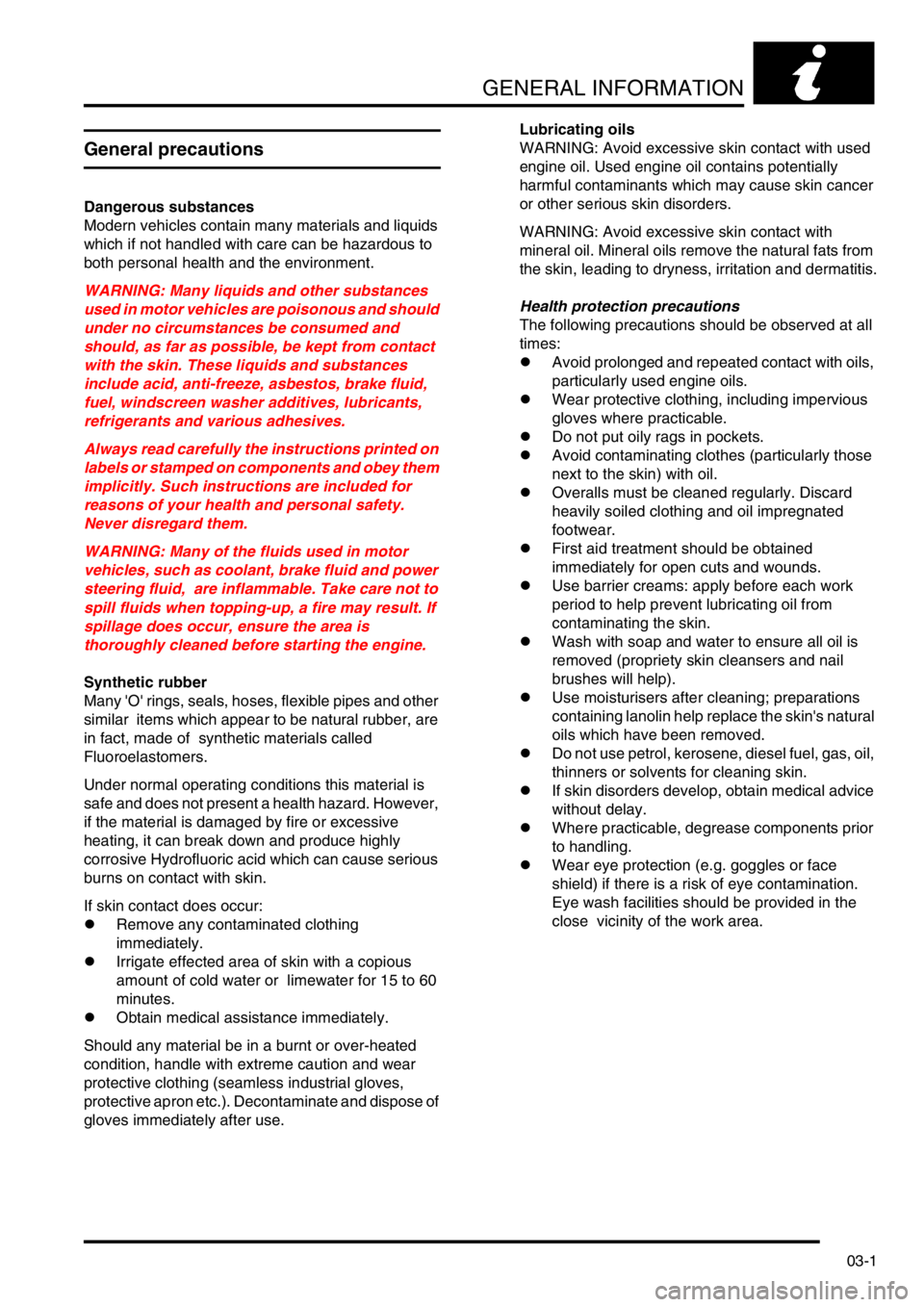
GENERAL INFORMATION
03-1
GENERAL INFORMATION
General precautions
Dangerous substances
Modern vehicles contain many materials and liquids
which if not handled with care can be hazardous to
both personal health and the environment.
WARNING: Many liquids and other substances
used in motor vehicles are poisonous and should
under no circumstances be consumed and
should, as far as possible, be kept from contact
with the skin. These liquids and substances
include acid, anti-freeze, asbestos, brake fluid,
fuel, windscreen washer additives, lubricants,
refrigerants and various adhesives.
Always read carefully the instructions printed on
labels or stamped on components and obey them
implicitly. Such instructions are included for
reasons of your health and personal safety.
Never disregard them.
WARNING: Many of the fluids used in motor
vehicles, such as coolant, brake fluid and power
steering fluid, are inflammable. Take care not to
spill fluids when topping-up, a fire may result. If
spillage does occur, ensure the area is
thoroughly cleaned before starting the engine.
Synthetic rubber
Many 'O' rings, seals, hoses, flexible pipes and other
similar items which appear to be natural rubber, are
in fact, made of synthetic materials called
Fluoroelastomers.
Under normal operating conditions this material is
safe and does not present a health hazard. However,
if the material is damaged by fire or excessive
heating, it can break down and produce highly
corrosive Hydrofluoric acid which can cause serious
burns on contact with skin.
If skin contact does occur:
lRemove any contaminated clothing
immediately.
lIrrigate effected area of skin with a copious
amount of cold water or limewater for 15 to 60
minutes.
lObtain medical assistance immediately.
Should any material be in a burnt or over-heated
condition, handle with extreme caution and wear
protective clothing (seamless industrial gloves,
protective apron etc.). Decontaminate and dispose of
gloves immediately after use.Lubricating oils
WARNING: Avoid excessive skin contact with used
engine oil. Used engine oil contains potentially
harmful contaminants which may cause skin cancer
or other serious skin disorders.
WARNING: Avoid excessive skin contact with
mineral oil. Mineral oils remove the natural fats from
the skin, leading to dryness, irritation and dermatitis.
Health protection precautions
The following precautions should be observed at all
times:
lAvoid prolonged and repeated contact with oils,
particularly used engine oils.
lWear protective clothing, including impervious
gloves where practicable.
lDo not put oily rags in pockets.
lAvoid contaminating clothes (particularly those
next to the skin) with oil.
lOveralls must be cleaned regularly. Discard
heavily soiled clothing and oil impregnated
footwear.
lFirst aid treatment should be obtained
immediately for open cuts and wounds.
lUse barrier creams: apply before each work
period to help prevent lubricating oil from
contaminating the skin.
lWash with soap and water to ensure all oil is
removed (propriety skin cleansers and nail
brushes will help).
lUse moisturisers after cleaning; preparations
containing lanolin help replace the skin's natural
oils which have been removed.
lDo not use petrol, kerosene, diesel fuel, gas, oil,
thinners or solvents for cleaning skin.
lIf skin disorders develop, obtain medical advice
without delay.
lWhere practicable, degrease components prior
to handling.
lWear eye protection (e.g. goggles or face
shield) if there is a risk of eye contamination.
Eye wash facilities should be provided in the
close vicinity of the work area.
Page 144 of 1007

CAPACITIES, FLUIDS, LUBRICANTS AND SEALANTS
09-1
CAPACITIES, FLUIDS, LUBRICANTS AND SEALANTS
Capacities
The following capacities are only an approximation of
the amount of fluid required to fill the respective
system.
Capacities – UK/ROW
† An extra 420 cc (0.73 imp pt) is required for
vehicles with an air blast fluid cooler fitted.
* Refill capacity is approx. 0.7 litre (1.125 imp. pt)
less than the from dry figures.
Capacities – NAS
Component / system Capacity
Fuel tank:
Td4 Model
K1.8 and KV6 Models
⇒ Up to 03 Model Year
⇒ From 03 Model Year
KV6 Model
⇒ Up to 03 Model Year
⇒ From 03 Model Year59 litres (13 gallons)
59 litres (13 gallons)
64 litres (14.3 gallons)
59 litres (13 gallons)
64 litres (14.3 gallons)
Engine - Td4 (including oil cooler and oil filter):
⇒ Refill 6.8 litres (12 imp. pts)
⇒ Fill from dry 7.3 litres (12.9 imp. pts)
Engine - K1.8 (including filter):
⇒ Refill 4.5 litres (7.9 imp. pts)
⇒ Fill from dry 4.8 litres (8.4 imp. pts)
Engine - KV6 (including oil cooler and filter):
⇒ Refill 5.2 litres (9.125 imp. pts)
⇒ Fill from dry 6.0 litres (10.625 imp. pts)
Manual gearbox - PG1:
⇒ Refill 2.0 litres (3.5 imp. pts)
⇒ From dry 2.2 litres (3.9 imp. pts)
Manual gearbox - Getrag:
⇒ Refill 1.6 litres (2.875 imp. pts)
⇒ From dry 1.67 litres (3 imp. pts)
Automatic gearbox - JATCO:
⇒ Refill 4.0 litres (7 imp. pts)
⇒ From dry
†8.5 litres (15 imp. pts)
Intermediate Reduction
Drive1.1 litres (2 imp. pts)
Rear differential:
⇒ Maximum 830 ml (29.2 imp. fl. oz.)
⇒ Minimum 750 ml (26.4 imp. fl. oz.)
Power steering reservoir 335 cm
3
Cooling system - Td4 Engine – Fill from dry (with
reservoir)*:
⇒ Automatic - Up to 03
Model Year
⇒ Automatic - From 03
Model Year7.25 litres (12.8 imp. pts)
7.35 litres (13 imp. pts)
⇒ Manual 7.25 litres (12.8 imp. pts)
Cooling system - K1.8 Engine:
⇒ Fill from dry (with
reservoir)*5.8 litres (10.25 imp. pts)
Cooling system - KV6 Engine:
⇒ Fill from dry (with
reservoir)*7.8 litres (13.75 imp. pts)
Reservoir tank:
⇒ Maximum fill 0.44 litres (0.75 imp. pts)
⇒ Expansion tank volume 1.2 litres (2.125 imp. pts)
⇒ Gross expansion
capacity0.72 litres (1.27 imp. pts)
Windscreen washer
reservoir 4.0 litres (7 imp. pints)
Component / system Capacity
Fuel tank:
⇒ Up to 02.5 Model Year
⇒ From 02.5 Model Year15.6 US gallons
17.2 US gallons
Engine - KV6 (including oil cooler and filter):
⇒ Engine oil and filter
change11 US pts
⇒ Fill from dry 12.7 US pts
Automatic gearbox - JATCO:
⇒ Refill 8.5 US pts
⇒ From dry 18.2 US pts
Intermediate Reduction
Drive2.3 US pts
Rear differential:
⇒ Maximum
⇒ Minimum28.1 US fl. oz.
25.4 US fl. oz.
Power steering reservoir 335 cm
3
Cooling system - KV6 Engine:
⇒ Fill from dry (with
reservoir)17.82 US pts
Reservoir tank:
⇒ Maximum fill 0.93 US pts
⇒ Expansion tank volume 2.54 US pts
⇒ Gross expansion
capacity1.52 US pts
Windscreen washer
reservoir 8.5 US pts Component / system Capacity
Page 148 of 1007
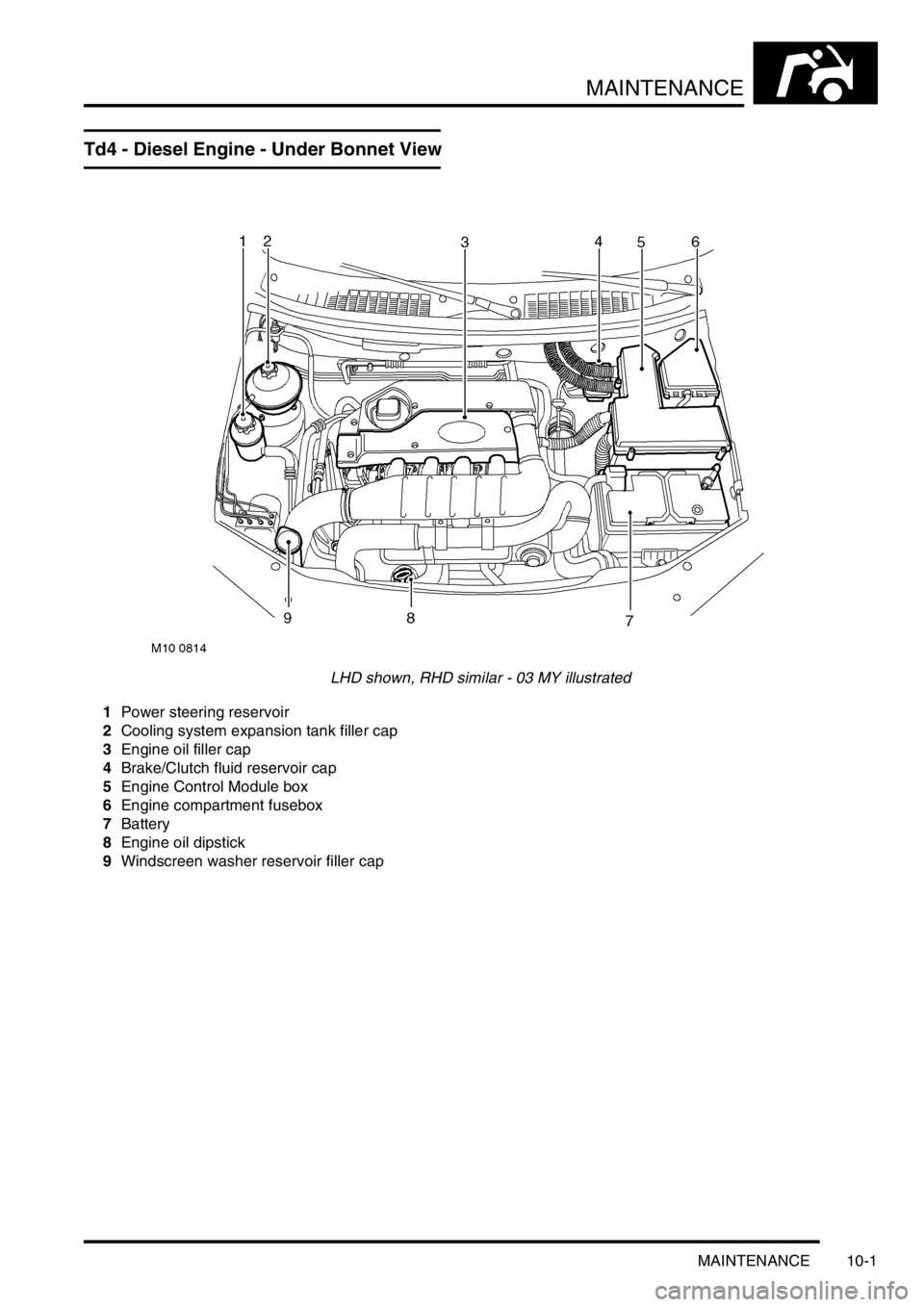
MAINTENANCE
MAINTENANCE 10-1
MAINTENANCE MAINTENANCE
Td4 - Diesel Engine - Under Bonnet View
LHD shown, RHD similar - 03 MY illustrated
1Power steering reservoir
2Cooling system expansion tank filler cap
3Engine oil filler cap
4Brake/Clutch fluid reservoir cap
5Engine Control Module box
6Engine compartment fusebox
7Battery
8Engine oil dipstick
9Windscreen washer reservoir filler cap
Page 149 of 1007
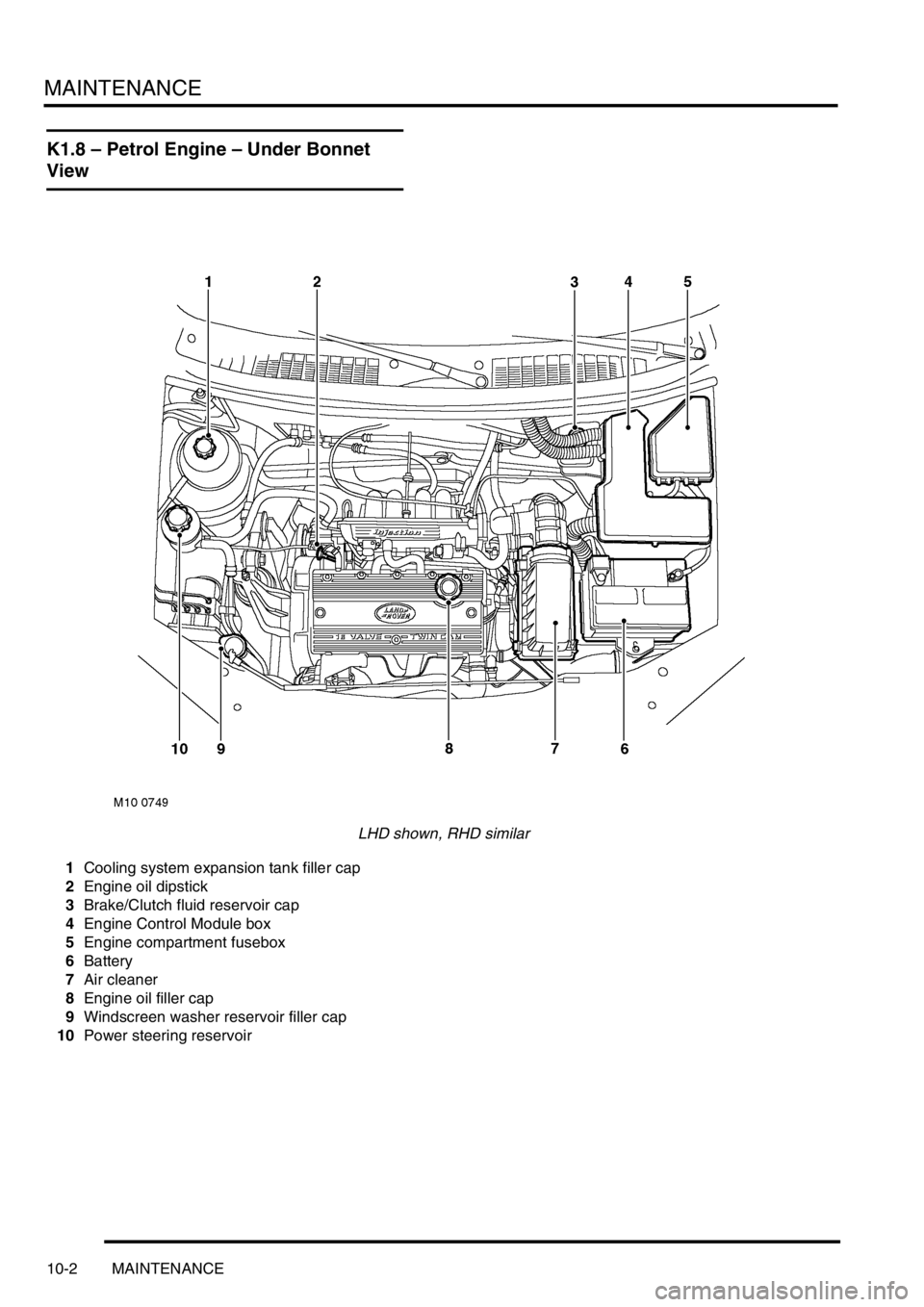
MAINTENANCE
10-2 MAINTENANCE
K1.8 – Petrol Engine – Under Bonnet
View
LHD shown, RHD similar
1Cooling system expansion tank filler cap
2Engine oil dipstick
3Brake/Clutch fluid reservoir cap
4Engine Control Module box
5Engine compartment fusebox
6Battery
7Air cleaner
8Engine oil filler cap
9Windscreen washer reservoir filler cap
10Power steering reservoir
Page 150 of 1007
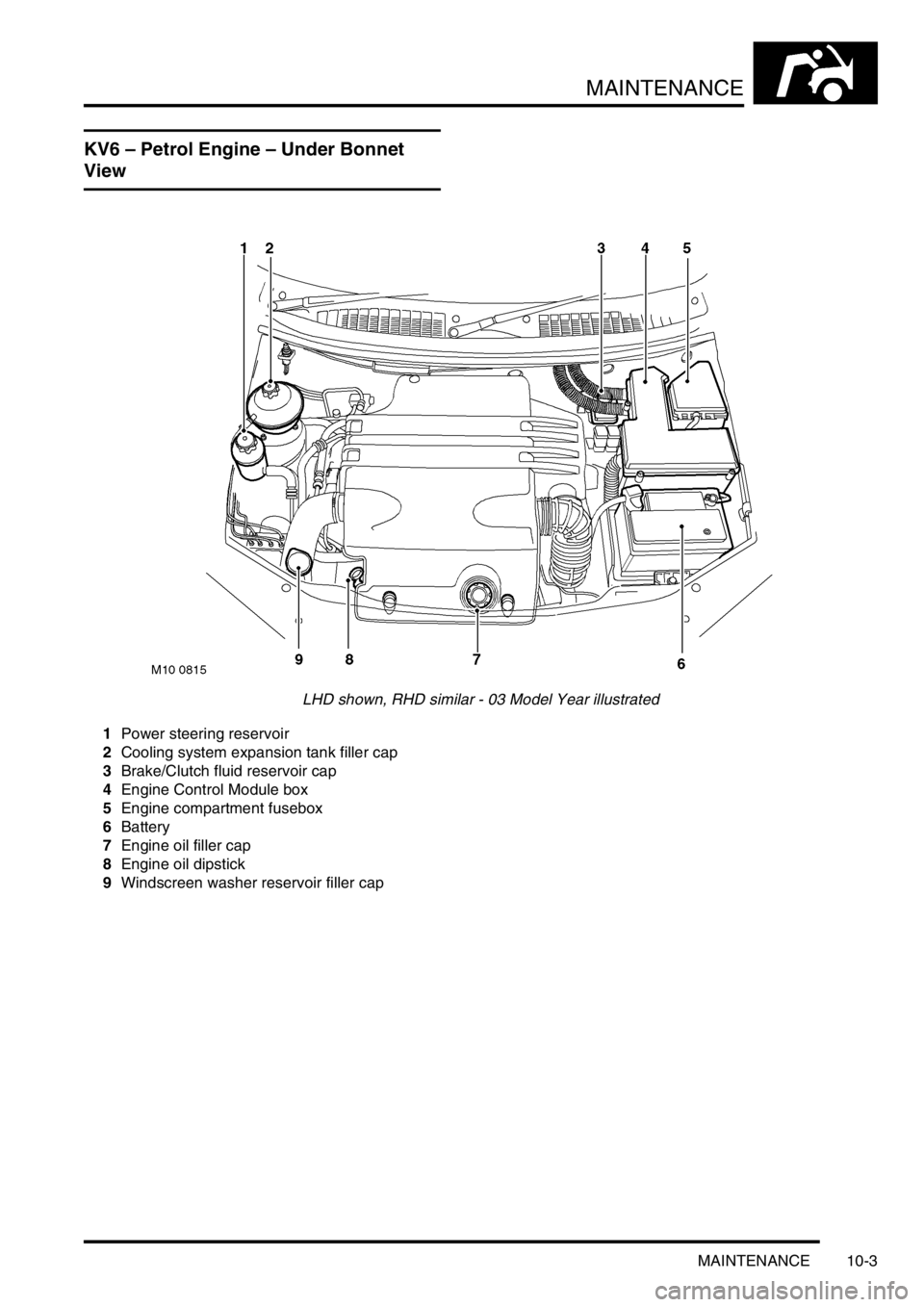
MAINTENANCE
MAINTENANCE 10-3
KV6 – Petrol Engine – Under Bonnet
View
LHD shown, RHD similar - 03 Model Year illustrated
1Power steering reservoir
2Cooling system expansion tank filler cap
3Brake/Clutch fluid reservoir cap
4Engine Control Module box
5Engine compartment fusebox
6Battery
7Engine oil filler cap
8Engine oil dipstick
9Windscreen washer reservoir filler cap
Page 164 of 1007
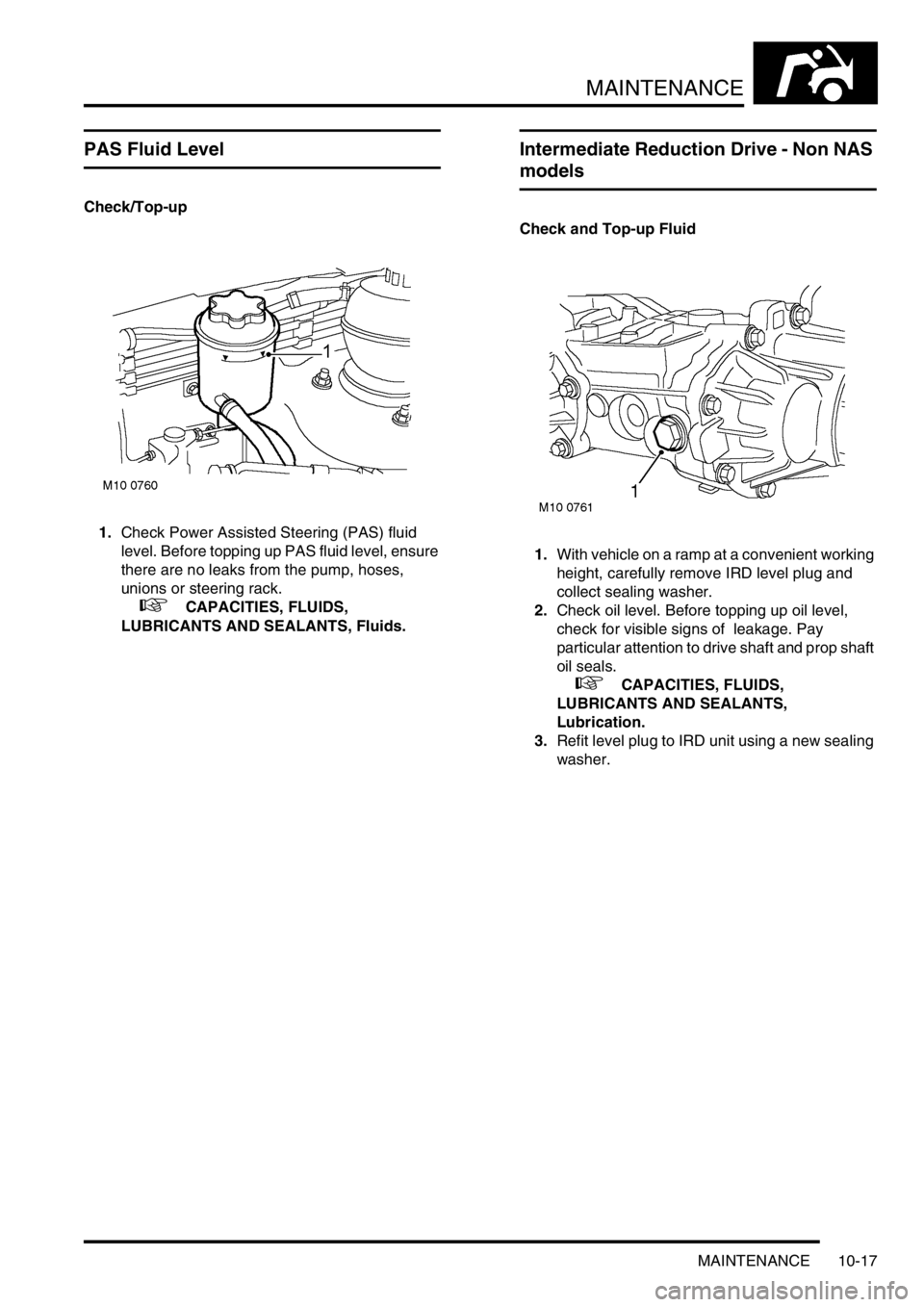
MAINTENANCE
MAINTENANCE 10-17
PAS Fluid Level
Check/Top-up
1.Check Power Assisted Steering (PAS) fluid
level. Before topping up PAS fluid level, ensure
there are no leaks from the pump, hoses,
unions or steering rack.
+ CAPACITIES, FLUIDS,
LUBRICANTS AND SEALANTS, Fluids.
Intermediate Reduction Drive - Non NAS
models
Check and Top-up Fluid
1.With vehicle on a ramp at a convenient working
height, carefully remove IRD level plug and
collect sealing washer.
2.Check oil level. Before topping up oil level,
check for visible signs of leakage. Pay
particular attention to drive shaft and prop shaft
oil seals.
+ CAPACITIES, FLUIDS,
LUBRICANTS AND SEALANTS,
Lubrication.
3.Refit level plug to IRD unit using a new sealing
washer.
Page 176 of 1007

MAINTENANCE
MAINTENANCE 10-29
Gear Change and Parking Pawl Engagement –
(Automatic only, normal driving conditions)
1.Select 'R' and check for smooth take up.
2.Select 'D' and check for smooth up-changes of
ratio from rest.
3.Slow down vehicle and check for smooth down-
changes of ratio.
4.Stop vehicle on a slope.
5.Select 'P' and release handbrake.
6.Check that vehicle does not move and that
selector does not slip out of 'P'.
7.Carry out a similar check with vehicle facing in
the opposite direction.
Steering
1.With vehicle stationary, turn steering from lock
to lock. Check for smooth operation and ensure
there is no undue noise from the power steering
pump or drive belt.
Suspension
1.Check for noise, irregularity in ride (e.g.
dampers) and wheel imbalance.
Foot brake
1.Check for pedal effort, travel, braking
efficiency, pulling and binding.
Handbrake
1.Apply handbrake firmly, check travel and
ratchet hold and release.
Instruments
1.Check for correct operation of all instruments
and warning devices where practical.
Body
1.Check for abnormal body noise.
Seat Belts
1.Check for operation of inertia reels.Road Test
1.Drive vehicle on a short road test. Check all
vehicle systems for correct operation. Pay
particular attention to:
lEngine noise
lGearbox noise
lSuspension noise
lBody noise
lBraking system operation
lGear selection
lEngine performance
2.Where possible, check for correct operation of
Hill Descent Control (HDC) system. This should
not be carried out if excessive journey time is
required.
3.After road test, carry out a final inspection of the
vehicle on vehicle ramps.
4.Check all underbonnet fluid levels and top-up if
necessary.
Page 494 of 1007
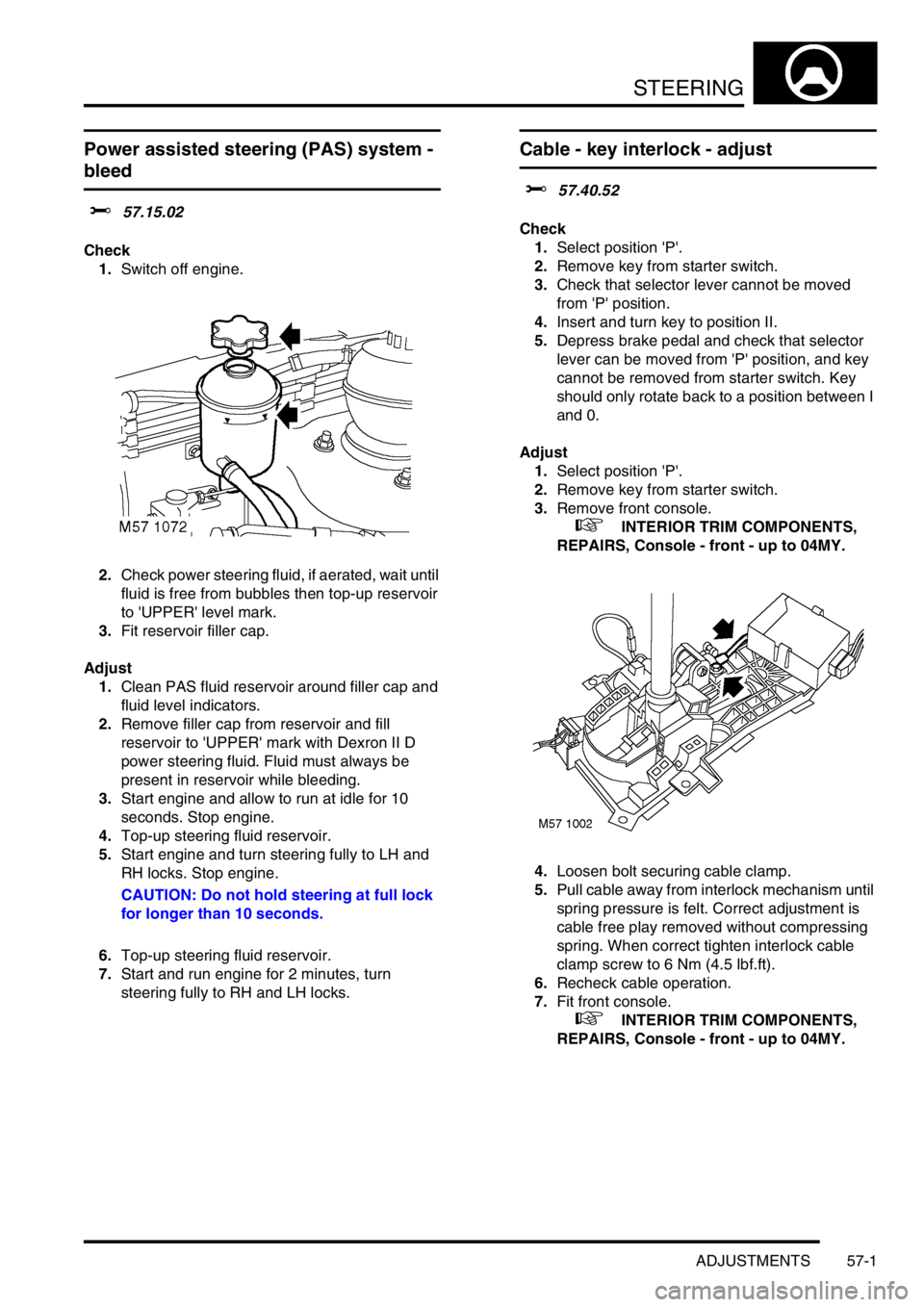
STEERING
ADJUSTMENTS 57-1
STEERING ADJUST ME NTS
Power assisted steering (PAS) system -
bleed
$% 57.15.02
Check
1.Switch off engine.
2.Check power steering fluid, if aerated, wait until
fluid is free from bubbles then top-up reservoir
to 'UPPER' level mark.
3.Fit reservoir filler cap.
Adjust
1.Clean PAS fluid reservoir around filler cap and
fluid level indicators.
2.Remove filler cap from reservoir and fill
reservoir to 'UPPER' mark with Dexron II D
power steering fluid. Fluid must always be
present in reservoir while bleeding.
3.Start engine and allow to run at idle for 10
seconds. Stop engine.
4.Top-up steering fluid reservoir.
5.Start engine and turn steering fully to LH and
RH locks. Stop engine.
CAUTION: Do not hold steering at full lock
for longer than 10 seconds.
6.Top-up steering fluid reservoir.
7.Start and run engine for 2 minutes, turn
steering fully to RH and LH locks.
Cable - key interlock - adjust
$% 57.40.52
Check
1.Select position 'P'.
2.Remove key from starter switch.
3.Check that selector lever cannot be moved
from 'P' position.
4.Insert and turn key to position II.
5.Depress brake pedal and check that selector
lever can be moved from 'P' position, and key
cannot be removed from starter switch. Key
should only rotate back to a position between I
and 0.
Adjust
1.Select position 'P'.
2.Remove key from starter switch.
3.Remove front console.
+ INTERIOR TRIM COMPONENTS,
REPAIRS, Console - front - up to 04MY.
4.Loosen bolt securing cable clamp.
5.Pull cable away from interlock mechanism until
spring pressure is felt. Correct adjustment is
cable free play removed without compressing
spring. When correct tighten interlock cable
clamp screw to 6 Nm (4.5 lbf.ft).
6.Recheck cable operation.
7.Fit front console.
+ INTERIOR TRIM COMPONENTS,
REPAIRS, Console - front - up to 04MY.
Page 497 of 1007
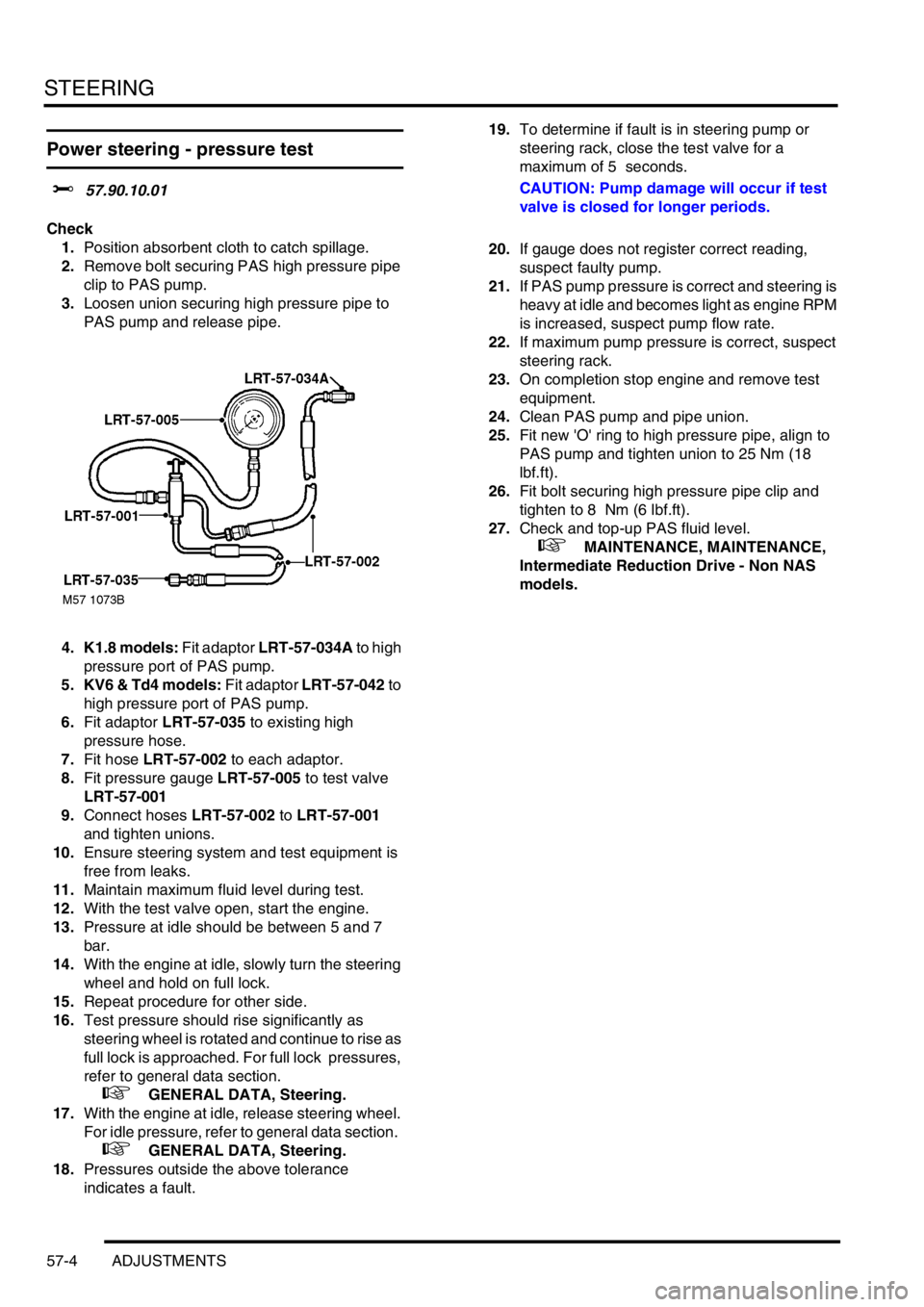
STEERING
57-4 ADJUSTMENTS
Power steering - pressure test
$% 57.90.10.01
Check
1.Position absorbent cloth to catch spillage.
2.Remove bolt securing PAS high pressure pipe
clip to PAS pump.
3.Loosen union securing high pressure pipe to
PAS pump and release pipe.
4. K1.8 models: Fit adaptor LRT-57-034A to high
pressure port of PAS pump.
5. KV6 & Td4 models: Fit adaptor LRT-57-042 to
high pressure port of PAS pump.
6.Fit adaptor LRT-57-035 to existing high
pressure hose.
7.Fit hose LRT-57-002 to each adaptor.
8.Fit pressure gauge LRT-57-005 to test valve
LRT-57-001
9.Connect hoses LRT-57-002 to LRT-57-001
and tighten unions.
10.Ensure steering system and test equipment is
free from leaks.
11.Maintain maximum fluid level during test.
12.With the test valve open, start the engine.
13.Pressure at idle should be between 5 and 7
bar.
14.With the engine at idle, slowly turn the steering
wheel and hold on full lock.
15.Repeat procedure for other side.
16.Test pressure should rise significantly as
steering wheel is rotated and continue to rise as
full lock is approached. For full lock pressures,
refer to general data section.
+ GENERAL DATA, Steering.
17.With the engine at idle, release steering wheel.
For idle pressure, refer to general data section.
+ GENERAL DATA, Steering.
18.Pressures outside the above tolerance
indicates a fault.19.To determine if fault is in steering pump or
steering rack, close the test valve for a
maximum of 5 seconds.
CAUTION: Pump damage will occur if test
valve is closed for longer periods.
20.If gauge does not register correct reading,
suspect faulty pump.
21.If PAS pump pressure is correct and steering is
heavy at idle and becomes light as engine RPM
is increased, suspect pump flow rate.
22.If maximum pump pressure is correct, suspect
steering rack.
23.On completion stop engine and remove test
equipment.
24.Clean PAS pump and pipe union.
25.Fit new 'O' ring to high pressure pipe, align to
PAS pump and tighten union to 25 Nm (18
lbf.ft).
26.Fit bolt securing high pressure pipe clip and
tighten to 8 Nm (6 lbf.ft).
27.Check and top-up PAS fluid level.
+ MAINTENANCE, MAINTENANCE,
Intermediate Reduction Drive - Non NAS
models.
Page 500 of 1007
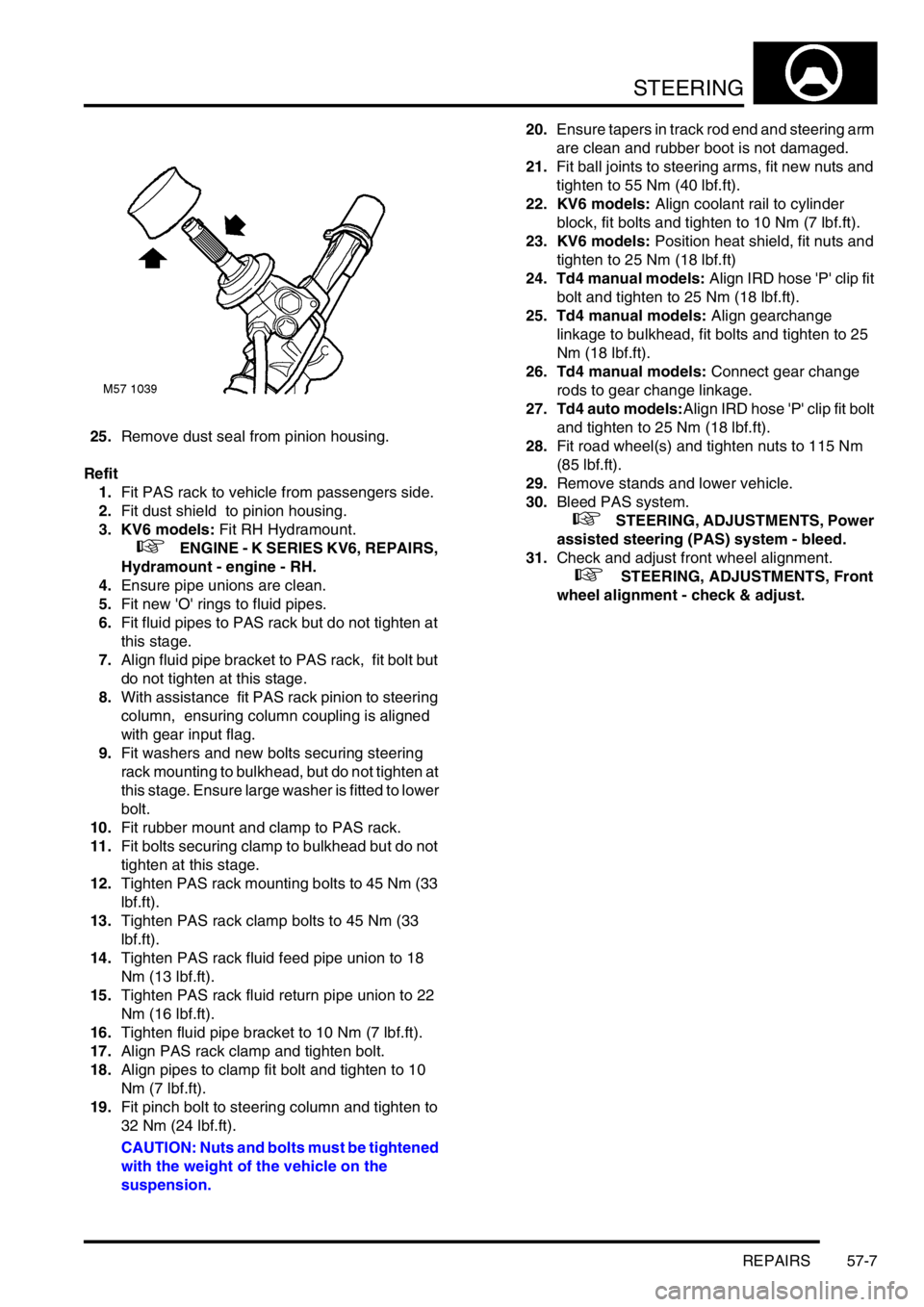
STEERING
REPAIRS 57-7
25.Remove dust seal from pinion housing.
Refit
1.Fit PAS rack to vehicle from passengers side.
2.Fit dust shield to pinion housing.
3. KV6 models: Fit RH Hydramount.
+ ENGINE - K SERIES KV6, REPAIRS,
Hydramount - engine - RH.
4.Ensure pipe unions are clean.
5.Fit new 'O' rings to fluid pipes.
6.Fit fluid pipes to PAS rack but do not tighten at
this stage.
7.Align fluid pipe bracket to PAS rack, fit bolt but
do not tighten at this stage.
8.With assistance fit PAS rack pinion to steering
column, ensuring column coupling is aligned
with gear input flag.
9.Fit washers and new bolts securing steering
rack mounting to bulkhead, but do not tighten at
this stage. Ensure large washer is fitted to lower
bolt.
10.Fit rubber mount and clamp to PAS rack.
11.Fit bolts securing clamp to bulkhead but do not
tighten at this stage.
12.Tighten PAS rack mounting bolts to 45 Nm (33
lbf.ft).
13.Tighten PAS rack clamp bolts to 45 Nm (33
lbf.ft).
14.Tighten PAS rack fluid feed pipe union to 18
Nm (13 lbf.ft).
15.Tighten PAS rack fluid return pipe union to 22
Nm (16 lbf.ft).
16.Tighten fluid pipe bracket to 10 Nm (7 lbf.ft).
17.Align PAS rack clamp and tighten bolt.
18.Align pipes to clamp fit bolt and tighten to 10
Nm (7 lbf.ft).
19.Fit pinch bolt to steering column and tighten to
32 Nm (24 lbf.ft).
CAUTION: Nuts and bolts must be tightened
with the weight of the vehicle on the
suspension.20.Ensure tapers in track rod end and steering arm
are clean and rubber boot is not damaged.
21.Fit ball joints to steering arms, fit new nuts and
tighten to 55 Nm (40 lbf.ft).
22. KV6 models: Align coolant rail to cylinder
block, fit bolts and tighten to 10 Nm (7 lbf.ft).
23. KV6 models: Position heat shield, fit nuts and
tighten to 25 Nm (18 lbf.ft)
24. Td4 manual models: Align IRD hose 'P' clip fit
bolt and tighten to 25 Nm (18 lbf.ft).
25. Td4 manual models: Align gearchange
linkage to bulkhead, fit bolts and tighten to 25
Nm (18 lbf.ft).
26. Td4 manual models: Connect gear change
rods to gear change linkage.
27. Td4 auto models:Align IRD hose 'P' clip fit bolt
and tighten to 25 Nm (18 lbf.ft).
28.Fit road wheel(s) and tighten nuts to 115 Nm
(85 lbf.ft).
29.Remove stands and lower vehicle.
30.Bleed PAS system.
+ STEERING, ADJUSTMENTS, Power
assisted steering (PAS) system - bleed.
31.Check and adjust front wheel alignment.
+ STEERING, ADJUSTMENTS, Front
wheel alignment - check & adjust.